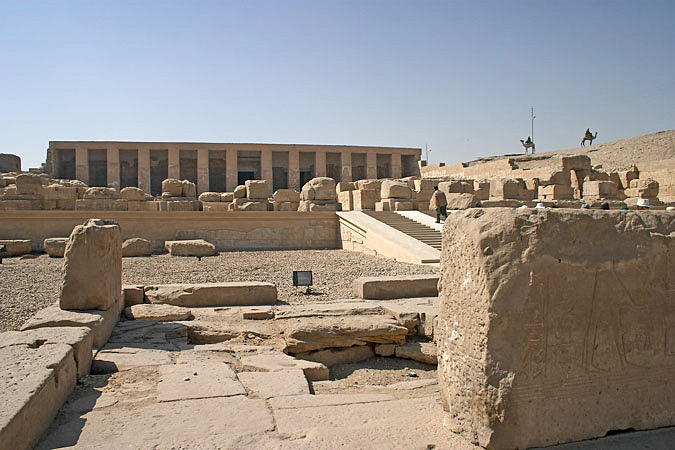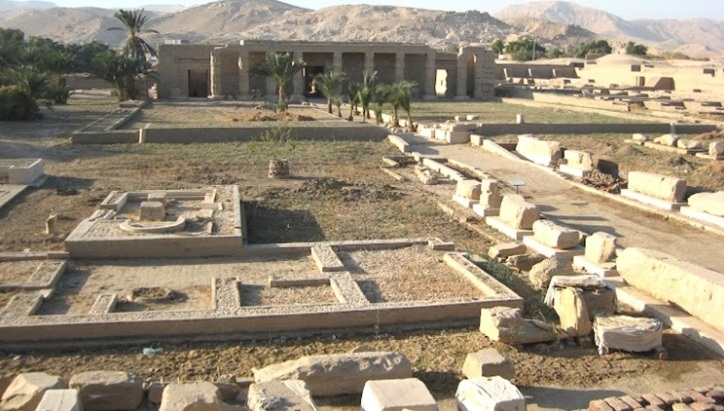Abydos Temple | Abydos Egypt
In the heart of Upper Egypt, about 90 kilometers north of Luxor, lies one of the most sacred and spiritually charged places in the entire Nile Valley — the Temple of Abydos, also known as the Temple of Seti I. Revered as the home of Osiris, the god of the afterlife, Abydos was more than a religious sanctuary — it was a symbol of rebirth, eternal life, and divine kingship.
From the dawn of Egyptian civilization, Abydos was considered a gateway to eternity, where kings and commoners alike sought the blessings of Osiris to ensure safe passage to the afterlife. Today, it stands as one of Egypt’s most beautifully preserved temples — a stunning blend of art, architecture, and sacred mystery that continues to captivate historians, pilgrims, and travelers alike.
The Sacred City of Osiris: The Soul of Ancient Egypt
Abydos is one of the oldest cities in Egypt, with a history stretching back to the Predynastic Period (before 3100 BC). It became famous as the cult center of Osiris, the god of death, resurrection, and eternal life.
According to ancient mythology, Osiris was murdered and dismembered by his brother Set, the god of chaos. His wife Isis collected his body parts and resurrected him long enough to conceive their son Horus, who avenged his father’s death and became the symbol of divine kingship.
Abydos was believed to be the burial place of Osiris’s head — making it the spiritual epicenter of the Egyptian afterlife. For millennia, Egyptians made pilgrimages here to honor Osiris and participate in festivals that reenacted his death and resurrection, celebrating the eternal victory of life over death.
Pharaoh Seti I and the Temple of Abydos
The most famous monument in Abydos is the Temple of Seti I, constructed during the 19th Dynasty (around 1290 BC). Seti I, the father of Ramses II (Ramses the Great), built this temple as both a house of worship and a monument to the gods and his own legacy.
Seti I’s reign marked a return to artistic refinement and religious devotion after the turbulent Amarna period of Akhenaten. His temple at Abydos became a masterpiece of New Kingdom art — its carvings are among the most detailed and finely executed in all of Egypt.
Although Seti I initiated the construction, his son Ramses II completed much of the decoration, continuing his father’s vision of a sacred monument that linked divine worship with royal power.

Architectural Splendor: Harmony in Stone
The Temple of Seti I is a marvel of Egyptian design and symmetry. Unlike most temples, which have straight axial layouts, this one has a unique L-shaped plan, with a series of seven sanctuaries dedicated to different deities.
The Seven Chapels
The temple’s central section includes seven beautifully decorated chapels, each devoted to one of Egypt’s major gods:
-
Osiris – Lord of the afterlife
-
Isis – Goddess of magic and motherhood
-
Horus – God of kingship
-
Amun-Ra – King of the gods
-
Ra-Horakhty – Sun god
-
Ptah – Creator god of Memphis
-
Seti I (Deified Pharaoh)
Each chapel features a symbolic barque (sacred boat) shrine and exquisitely carved reliefs showing Seti I performing offerings to the gods. These scenes are celebrated for their delicate lines, balanced composition, and lifelike expressions, which set new artistic standards in temple decoration.
Hypostyle Halls and Columns
The temple begins with two hypostyle halls supported by massive stone columns decorated with images of the pharaoh and deities. The ceilings are covered with stars, symbolizing the eternal sky — a reminder that this was not just a temple, but a cosmic space connecting heaven and earth.
Hieroglyphs, deeply carved into the limestone walls, retain their original clarity and elegance, making Abydos one of the best places to study the language and symbolism of ancient Egypt.
The Abydos King List: A Pharaoh’s Legacy
One of the most significant features of the Temple of Seti I is the Abydos King List, an invaluable historical record carved on a wall in one of the temple’s corridors.
The list contains the cartouches of 76 pharaohs, beginning with Menes (the first king of unified Egypt) and ending with Seti I himself. This chronological sequence omits certain rulers — notably the controversial pharaohs Hatshepsut and Akhenaten — but it provides an essential framework for understanding Egypt’s dynastic history.
The Abydos King List was a way for Seti I to legitimize his reign by aligning himself with Egypt’s most revered rulers. It remains a key archaeological discovery, offering historians one of the earliest and most complete royal genealogies in Egyptian history.

The Osireion: Tomb of the God
Behind the main temple lies the mysterious Osireion, an underground structure believed to represent the tomb of Osiris himself. Built with massive granite blocks in a style reminiscent of the Old Kingdom, the Osireion sits below ground level, symbolizing the subterranean world of the afterlife.
A central stone platform surrounded by a trench of water creates a symbolic “island of creation,” mirroring the primeval mound from which the world emerged in Egyptian mythology.
Although its exact function remains debated — some suggest it was a cenotaph or symbolic tomb — the Osireion clearly held immense religious significance. Ancient visitors regarded it as the resting place of Osiris’s body, and pilgrims left offerings and prayers for resurrection and renewal.
The Osireion’s mysterious atmosphere, with its massive columns and echoes of ancient chants, continues to inspire awe among visitors even today.
Art and Symbolism: The Language of Eternity
Abydos Temple is often described as a visual hymn — its walls, ceilings, and columns all serve as sacred texts expressing profound religious concepts.
Reliefs and Colors
The reliefs of Seti I’s temple are among the finest in Egypt. Figures of gods and pharaohs are depicted with grace and elegance, their faces serene, their bodies perfectly proportioned. Traces of the original pigments — reds, blues, and golds — still cling to the stone, hinting at the temple’s former brilliance.
The scenes depict everything from daily rituals to grand mythological events: Seti I offering incense to Osiris, Isis embracing the resurrected god, and Horus presenting the symbols of life and power.
Spiritual Symbolism
Every part of the temple carries symbolic meaning. The outer walls represent the mortal world, while the inner sanctuaries embody the divine realm. Walking through the temple was seen as a spiritual journey — from life into eternity.
The deep carvings, the rhythmic symmetry, and the serene atmosphere were all designed to elevate the soul, connecting the worshiper directly to the divine essence of Osiris.

The City of Abydos: A Pilgrimage Site
Beyond the temple itself, the ancient city of Abydos was one of Egypt’s most sacred pilgrimage destinations. From as early as the First Dynasty, kings built cenotaphs (symbolic tombs) here to associate themselves with Osiris.
The most notable royal burial site in the area is the tomb of Pharaoh Djer, which later Egyptians believed to be the actual tomb of Osiris. During the Middle and New Kingdoms, thousands of Egyptians traveled to Abydos to take part in religious festivals — especially the Osiris Mysteries, dramatic reenactments of the god’s death and resurrection.
Pilgrims brought small stelae (stone tablets) inscribed with prayers, many of which have been discovered around the temple complex. These inscriptions reveal the deep emotional and spiritual connection people felt toward Osiris and the hope for eternal life he represented.
Ramses II’s Temple at Abydos
Next to the Temple of Seti I stands another impressive structure built by his son, Ramses II. Though smaller and less intricate, the Temple of Ramses II at Abydos features powerful scenes of the king’s military triumphs and devotion to the gods.
Among its reliefs is a depiction of the Battle of Kadesh, one of the most famous military engagements in ancient history. This temple complements Seti I’s, showing the continuity of worship and royal legacy within the same sacred landscape.
Rediscovery and Modern Preservation
For centuries, Abydos was buried beneath sand and forgotten ruins until European explorers rediscovered it in the 19th century. Scholars such as Flinders Petrie, Auguste Mariette, and Amélineau conducted some of the earliest archaeological excavations here, uncovering invaluable insights into early dynastic Egypt.
Today, the Egyptian Ministry of Tourism and Antiquities continues to protect and preserve Abydos. Modern conservation projects focus on stabilizing the reliefs, cleaning soot from the ceilings, and preventing groundwater damage.
Because of its exceptional preservation, Abydos Temple remains one of the best places in Egypt to witness original New Kingdom art in its full detail and spiritual depth.

Visiting Abydos Today
Location:
Abydos is located in Sohag Governorate, about 90 km north of Luxor.
Opening Hours:
Open daily from 8:00 AM to 5:00 PM.
Ticket Prices (as of 2025):
-
General Admission: 200 EGP
-
Student Ticket: 100 EGP
How to Get There:
-
From Luxor: The easiest route is a day trip by car or organized tour, taking around 2 hours each way.
-
By Train: Trains from Luxor or Cairo stop at Al Balyana Station, about 11 km from the temple. From there, taxis or local minibuses can take you to the site.
Visitor Tips:
-
Visit early in the morning to avoid crowds and capture the best light for photography.
-
Take a flashlight to better view carvings in the inner chambers.
-
Bring water and comfortable shoes — the temple grounds are expansive.
-
Combine your visit with Dendera Temple, often included in the same day tour.
Nearby Attractions
Abydos pairs beautifully with several nearby archaeological treasures:
-
Dendera Temple: Dedicated to Hathor, just 60 km south — known for its colorful ceilings.
-
Akhmim: An ancient city with ruins from the Pharaonic and Greco-Roman eras.
-
Luxor: Home to the Valley of the Kings, Karnak, and Luxor temples — a natural continuation of your historical journey.
Together, these sites reveal the full spectrum of Egypt’s spiritual and artistic evolution.
The Eternal Legacy of Abydos
What makes Abydos truly timeless is its spiritual energy. This was not merely a temple but a sacred link between the human and divine. Pharaohs built here not just to honor the gods, but to ensure their own eternal life alongside them.
Even today, visitors sense a deep stillness — a feeling of reverence and transcendence — as they walk through its halls. The artistry, the legends, and the sacred geometry all work together to awaken the same wonder the ancient Egyptians must have felt 3,000 years ago.
Abydos reminds us that life, death, and rebirth are all part of a single, eternal cycle — a truth the Egyptians expressed not with words, but with stone, color, and devotion.
Conclusion: Journey to the Soul of Egypt
The Abydos Temple is more than an archaeological site — it is a living testament to Egypt’s spiritual genius and artistic perfection. From its divine carvings to the mysteries of the Osireion, Abydos embodies the Egyptian belief that life is eternal and that the soul, like Osiris, can rise again.
Whether you are a traveler, historian, or seeker of ancient wisdom, a visit to Abydos is a journey through time — a chance to stand where pharaohs prayed, where gods were worshiped, and where the ancient world’s most profound mysteries still whisper from the stones.
Visit Abydos Temple — walk in the footsteps of Seti I, explore the sacred home of Osiris, and experience the timeless magic of Egypt’s eternal city today!

